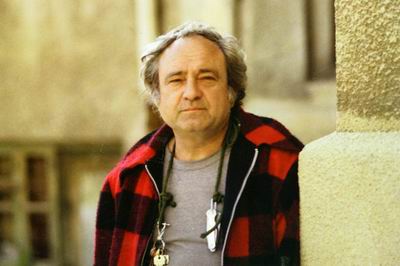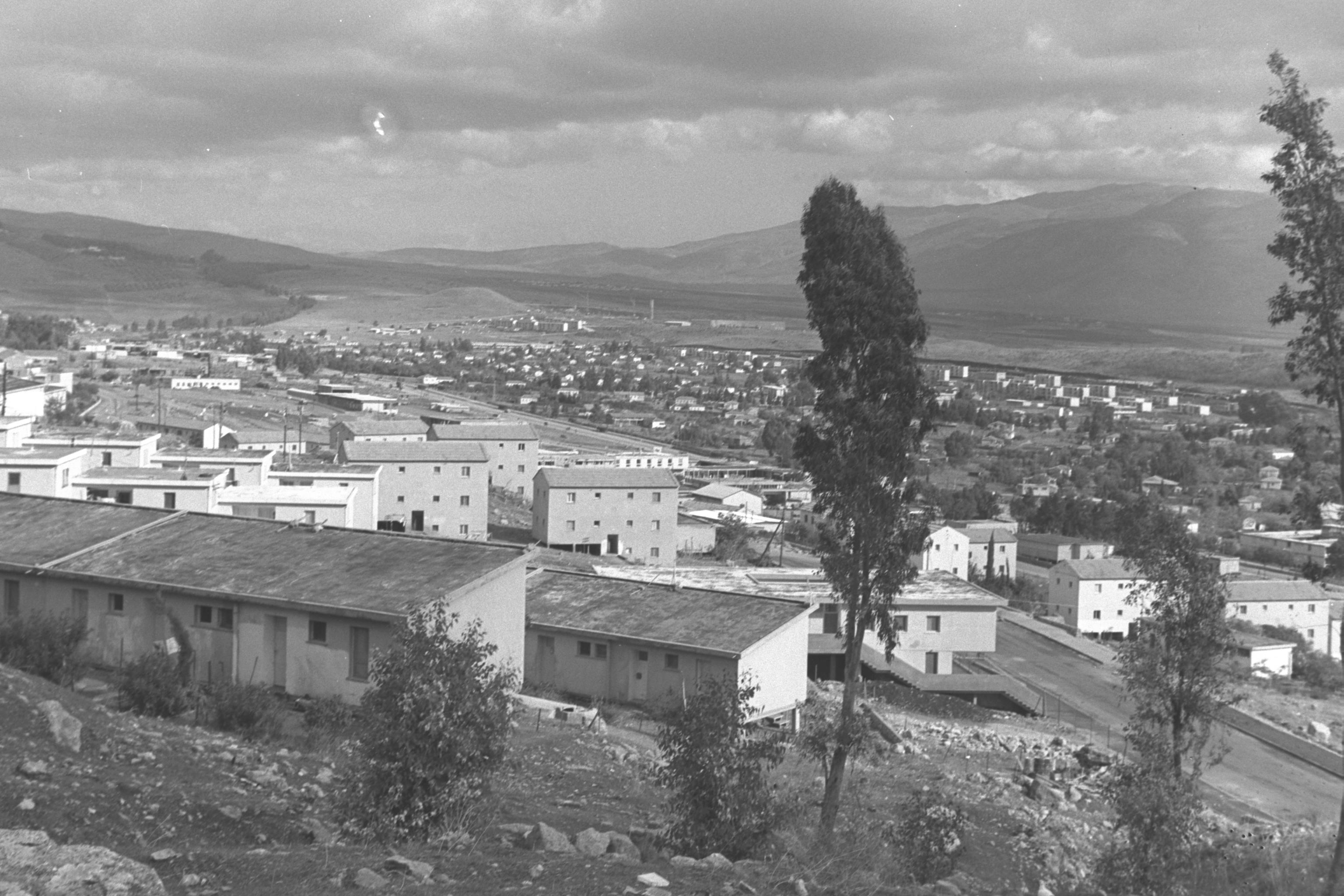|
Yigal Tumarkin
Igael Tumarkin (Hebrew: יגאל תומרקין; 23 October 1933 – 12 August 2021) was an Israeli painter and sculptor. Biography Peter Martin Gregor Heinrich Hellberg (later Igael Tumarkin) was born in 1933 in Dresden, Saxony, Germany. His father, Martin Hellberg, was a German theater actor and director, and a son of a pastor. His Jewish mother, Berta Gurevitch, and his stepfather, Herzl Tumarkin, immigrated to then British Mandate of Palestine (now Israel) when he was two. Tumarkin served in the Israeli Navy. After completing his military service, he studied sculpture in Ein Hod, a village of artists near Mount Carmel, under Rudi Lehmann. His youngest son is the actor Yon Tumarkin. Tumarkin died at the age of 87 on 12 August 2021. Art career Among Tumarkin's best known works are the Holocaust and Revival memorial in Rabin Square, Tel Aviv and his sculptures commemorate fallen soldiers in the Negev. Tumarkin was also an art theoretician and stage designer. In the 1950s, T ... [...More Info...] [...Related Items...] OR: [Wikipedia] [Google] [Baidu] |
Dresden
Dresden (, ; Upper Saxon: ''Dräsdn''; wen, label=Upper Sorbian, Drježdźany) is the capital city of the German state of Saxony and its second most populous city, after Leipzig. It is the 12th most populous city of Germany, the fourth largest by area (after Berlin, Hamburg and Cologne), and the third most populous city in the area of former East Germany, after Berlin and Leipzig. Dresden's urban area comprises the towns of Freital, Pirna, Radebeul, Meissen, Coswig, Radeberg and Heidenau and has around 790,000 inhabitants. The Dresden metropolitan area has approximately 1.34 million inhabitants. Dresden is the second largest city on the River Elbe after Hamburg. Most of the city's population lives in the Elbe Valley, but a large, albeit very sparsely populated area of the city east of the Elbe lies in the West Lusatian Hill Country and Uplands (the westernmost part of the Sudetes) and thus in Lusatia. Many boroughs west of the Elbe lie in the foreland of the Ore Mounta ... [...More Info...] [...Related Items...] OR: [Wikipedia] [Google] [Baidu] |
Holocaust And Revival
The Holocaust, also known as the Shoah, was the genocide of European Jews during World War II. Between 1941 and 1945, Nazi Germany and its collaborators systematically murdered some six million Jews across German-occupied Europe; around two-thirds of Europe's Jewish population. The murders were carried out in pogroms and mass shootings; by a policy of extermination through labor in concentration camps; and in gas chambers and gas vans in German extermination camps, chiefly Auschwitz-Birkenau, Bełżec, Chełmno, Majdanek, Sobibór, and Treblinka in occupied Poland. Germany implemented the persecution in stages. Following Adolf Hitler's appointment as chancellor on 30 January 1933, the regime built a network of concentration camps in Germany for political opponents and those deemed "undesirable", starting with Dachau on 22 March 1933. After the passing of the Enabling Act on 24 March, which gave Hitler dictatorial plenary powers, the government began isolating Jews ... [...More Info...] [...Related Items...] OR: [Wikipedia] [Google] [Baidu] |
Kiryat Shmona
Kiryat Shmona ( he, קִרְיַת שְׁמוֹנָה, ''lit.'' Town of the Eight) is a city in the Northern District of Israel on the western slopes of the Hula Valley near the Lebanese border. The city was named after the eight people, including Joseph Trumpeldor, who died in 1920 defending Tel Hai. In it had a population of , the majority of whom are Jews, particularly of Moroccan descent. Located near the Israel–Lebanon border, Kiryat Shmona is Israel's northernmost city. History The town of Kiryat Shmona was established in 1949 on the site of the former Palestinian village al-Khalisa, whose inhabitants had fled after Safed was taken by the Haganah during the 1948 Arab–Israeli War and an attempt by the village to come to an agreement with the Jewish authorities was rejected. Literally ''The town of the Eight'', Kiryat Shmona was named after eight Jewish militiamen, commanded by Joseph Trumpeldor, who had fallen in the 1920 Battle of Tel Hai during the Franco-Syrian War ... [...More Info...] [...Related Items...] OR: [Wikipedia] [Google] [Baidu] |
Atlit
Atlit ( he, עַתְלִית, ar, عتليت) is a coastal town located south of Haifa, Israel. The community is in the Hof HaCarmel Regional Council in the Haifa District of Israel. Off the coast of Atlit is a submerged Neolithic village. Atlit was also a Crusader outpost, the Château Pèlerin, which fell to the Mamluks in 1291. During their rule, in the 14th century, it became home to a large concentration of Oirat Mongols. During early Ottoman rule, in the 16th century, it was recorded in tax registers as a port of call and a farm. Later, in the 19th century, it was a small Arab fishing village under the influence of the local al-Madi family. An adjacent Jewish village was reestablished in 1903 under the auspices of Baron Edmond de Rothschild, which merged with the remnants of the Crusader fortress village. The Atlit detainee camp is nearby, which was used by the British to intern Jewish refugees and is now a museum. From 1950 until the unification of the municipalities ... [...More Info...] [...Related Items...] OR: [Wikipedia] [Google] [Baidu] |
Kiryat Yam
Kiryat Yam ( he, קִרְיַת יָם, lit. ''Sea Town'') is a city in the Haifa Bay district of Israel, north of Haifa. One of a group of Haifa suburbs known as the Krayot, it is located on the Mediterranean coast, between Kiryat Haim and the Tzur Shalom industrial area, east of Kiryat Motzkin. In it had a population of . History The area was acquired by the Jewish community as part of the Sursock Purchase, in which a large tract of land on the Haifa Bay was purchased from the Sursock family of Beirut by the American Zion Commonwealth in 1925. In 1928, the Bayside Land Corporation, a joint venture of the Palestine Economic Corporation and the Jewish National Fund, acquired 2,400 dunams of residential land in a deal related to the building of the IPC oil pipeline.Glass, 2002, p 236/ref> Development of a residential area began in 1939, and the first houses were completed in 1940. Demographics Kiryat Yam has a population of 38,945. The northern area of the city is home to man ... [...More Info...] [...Related Items...] OR: [Wikipedia] [Google] [Baidu] |
Dimona
Dimona ( he, דִּימוֹנָה, ar, ديمونا) is an Israeli city in the Negev desert, to the south-east of Beersheba and west of the Dead Sea above the Arava valley in the Southern District of Israel. In its population was . The Shimon Peres Negev Nuclear Research Center, colloquially known as the ''Dimona Reactor'', is located southeast of the city. Etymology The Negev Naming Committee chose the name based upon that of a biblical town, mentioned in Joshua 15:21-22, on the basis that "the sound of this name had been preserved in the Arabic name Harabat Umm Dumna." History Dimona was one of the development towns created in the 1950s under the leadership of Israel's first Prime Minister, David Ben-Gurion. Dimona itself was conceived in 1953. The location chosen was close to the Dead Sea Works. It was established in 1955. The first residents were Jewish immigrants from North Africa, with an initial 36 families being the first to settle there. Its population in 1955 ... [...More Info...] [...Related Items...] OR: [Wikipedia] [Google] [Baidu] |
Mitzpe Moav
{{geodis ...
Mitzpe, a Hebrew word meaning ''lookout'', may refer to the following places in Israel: *Mitzpe Aviv *Mitzpe Dani *Mitzpe Dona Gracia *Mitzpe Eshtemoa *Mitzpe Hagit *Mitzpe Hila *Mitzpe Ilan *Mitzpe Kramim *Mitzpe Netofa *Mitzpe Ramon *Mitzpe Shalem *Mitzpe Yair *Mitzpe Yeriho *Mitzpe Yosef Mitzpe Yosef ( he, מִצְפֵּה יוֹסֵף, ''lit.'' Joseph's Lookout) is an Israeli outpost in the Israeli-occupied West Bank. Located on Mount Gerizim near Nablus, it falls within the jurisdiction of Shomron Regional Council. The popula ... [...More Info...] [...Related Items...] OR: [Wikipedia] [Google] [Baidu] |
Israel Museum
The Israel Museum ( he, מוזיאון ישראל, ''Muze'on Yisrael'') is an art and archaeological museum in Jerusalem. It was established in 1965 as Israel's largest and foremost cultural institution, and one of the world’s leading encyclopaedic museums. It is situated on a hill in the Givat Ram neighborhood of Jerusalem, adjacent to the Bible Lands Museum, the Knesset, the Israeli Supreme Court, and the Hebrew University of Jerusalem. Its holdings include the world's most comprehensive collections of the archaeology of the Holy Land, and Jewish art and life, as well as significant and extensive holdings in the fine arts, the latter encompassing eleven separate departments: Israeli Art, European Art, Modern Art, Contemporary Art, Prints and Drawings, Photography, Design and Architecture, Asian Art, African Art, Oceanic Art, and Arts of the Americas. Among the unique objects on display are the Venus of Berekhat Ram, the interior of a 1736 Zedek ve Shalom synagogue from Sur ... [...More Info...] [...Related Items...] OR: [Wikipedia] [Google] [Baidu] |
Sandberg Prize
The Sandberg Prize for Israeli Art refers to a prize for art and design awarded at the Israel Museum, Jerusalem, with a particular focus on Israeli art. The prize was inaugurated in 1968 with funds from an anonymous New York–based donor. The prize is named in honor of Willem Sandberg, who served between 1964 and 1968 as chairman of the Executive Committee of the Israel Museum, which opened in 1965. History The Sandberg Prize Foundation was established with a 75 thousand dollar fund which was earmarked for the purchase of Israeli art, and to be awarded to artists for their work. The anonymous donor requested to honor the work that Sandberg had done to promote Modern Art in Israel and with the intention of supporting the proliferation of art in Israel. Joseph Zaritsky was the first artist to be awarded the prize 2 January 1968. The panel of judges for the prize included Sandberg and Yonah Fisher. The prize was given to Zaritsky for the 1964 painting which paid homage to Jan Ver ... [...More Info...] [...Related Items...] OR: [Wikipedia] [Google] [Baidu] |
Berliner Ensemble
The Berliner Ensemble () is a German theatre company established by actress Helene Weigel and her husband, playwright Bertolt Brecht, in January 1949 in East Berlin. In the time after Brecht's exile, the company first worked at Wolfgang Langhoff's Deutsches Theater and in 1954 moved to the Theater am Schiffbauerdamm, built in 1892, that was open for the 1928 premiere of ''The Threepenny Opera'' (''Die Dreigroschenoper''). Bertolt Brecht's Berliner Ensemble Brecht's students Benno Besson, Egon Monk, Peter Palitzsch, and Manfred Wekwerth were given the opportunity to direct plays by Brecht that had not yet been staged. The stage designers Caspar Neher and Karl von Appen, the composers Paul Dessau and Hanns Eisler, as well as the dramaturge Elisabeth Hauptmann, were among Brecht's closest collaborators. After her husband died in 1956, Weigel continued managing the Berliner Ensemble until her death in 1971. The Berliner Ensemble achieved success through long and meticulous rehears ... [...More Info...] [...Related Items...] OR: [Wikipedia] [Google] [Baidu] |







